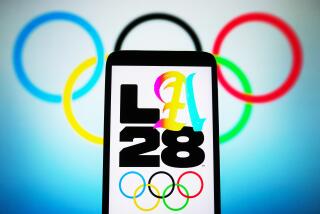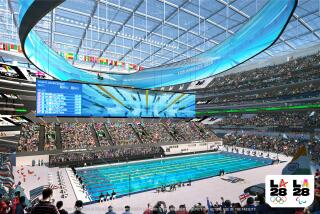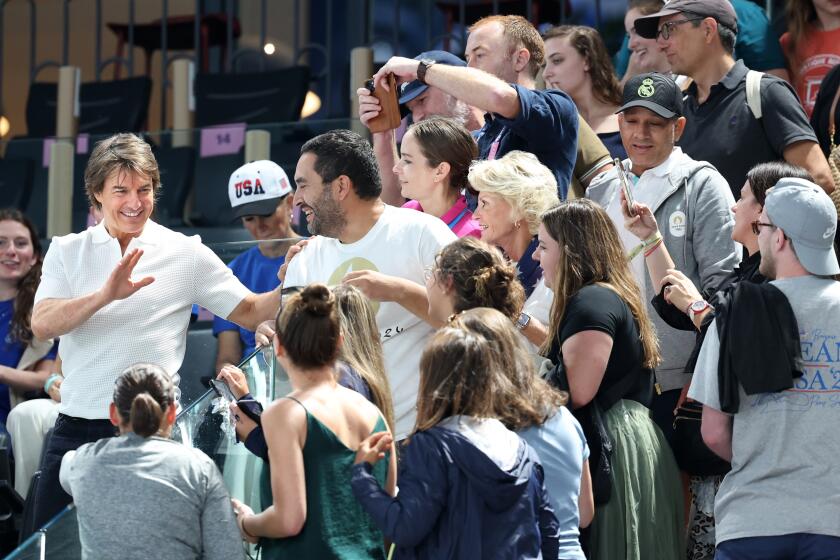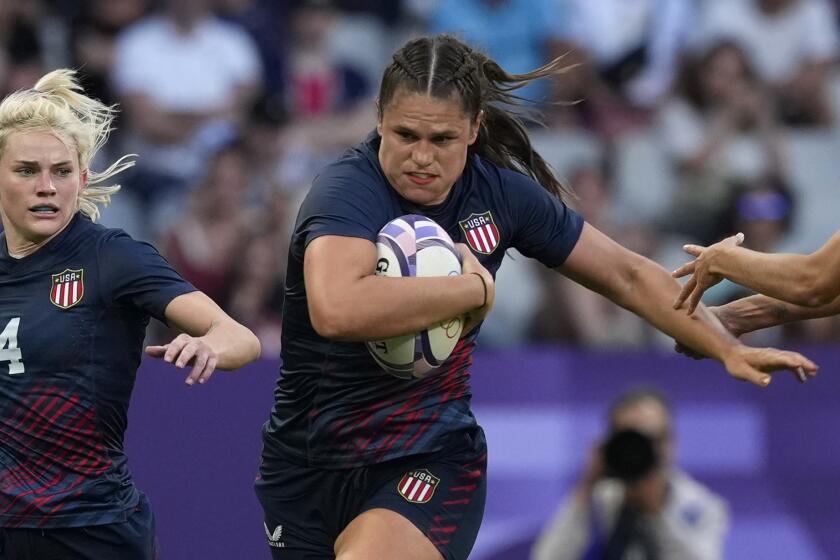Surplus From L.A. Olympics Is Money for Area’s Future
The Los Angeles Olympics made one of the greatest profits of any sports event in history, $222.7 million.
That surplus, primarily locked away in two major funds, will, by all indications, be distributed in bits and pieces well into the next century.
In fact, because of the policies of foundations affiliated with the U.S. Olympic Committee and a successor to the Los Angeles Olympic Organizing Committee, the Amateur Athletic Foundation, the principal of the surplus has been conserved. With the exception of about $44 million that went to national sports federations, only the interest income has been handed out in grants.
The heads of the two foundations say this is better than spending it all at once because the money can benefit youth sports for a generation or even more, being used selectively when it is most needed.
But the result is that the 1984 surplus has not yet been used dramatically.
David Wolper, who recently became chairman of the Amateur Athletic Foundation, which controls the portion of the surplus dedicated to youth sports in Southern California, has said he wants to make a bigger immediate impact with the money than in the last four years. So far, however, the policy of restrained spending continues.
According to terms of the original contract between the Los Angeles Olympic organizers and the International Olympic Committee, the surplus from the 1984 Games was to be split 40% to the U.S. Olympic Committee, 40% to Southern California and 20% to the national sports governing bodies.
The USOC, often financially strapped, decided to put almost all of its share into an endowment, creating the U.S. Olympic Foundation with the surplus funds it received, along with funds collected through a U.S. government commemorative Olympic coin program.
“The foundation was the realization of a dream that (former USOC president) Bill Simon and I had 25 years ago,” said F. Don Miller, who became foundation president after his retirement in 1985 as USOC executive director.
“The Games provided a once-in-a-lifetime opportunity to assist amateur sports in our country over the long term.”
Miller said that because of an aggressive investment policy, the money has actually grown since it was deposited in 1985. With the coin money, he said, the original U.S. Olympic Foundation fund was $110 million. Despite making about $22 million in grants to the USOC and its member organizations since then, its present assets are $155 million, he said.
The Amateur Athletic Foundation, with a more conservative investment policy, has, by contrast, increased its fund only slightly.
According to figures made available by foundation president Anita DeFrantz, the Southern California fund received an initial $88.6 million from the Los Angeles Olympic Organizing Committee, which conserved a small part of the surplus against possible litigation and will distribute it later.
After an outlay in grants and programs of a little more than $25 million in its first three years, the foundation has assets of $89.4 million at this time, DeFrantz said.
The Amateur Athletic Foundation recently completed a $3-million Sports Resource Center, named after its first board chairman, Paul Ziffren, to serve as a library and conference site for area sports activists.
However, the foundation’s most important activities have been represented by its grants, which amount to nearly $15 million and its own programs, exclusive of building and equipping the Ziffren center, valued at nearly $5 million.
Aside from a $2-million one-time grant to provide seed money for a Los Angeles Arts Festival, all of the money spent has been devoted to youth sports, and this will be the pattern of the future, according to foundation leaders.
Major grants so far have included $349,990 for sports programs organized by the East Los Angeles-based Community Youth Gang Services, $550,000 for a Boy Scouts Waterfront Youth Sports Program in San Pedro, $250,000 to help finance a new Rose Bowl Aquatics Center, $401,200 for sports activities of the Boys Clubs of America and $1.3 million to support summer programs of the Los Angeles City Department of Recreation and Parks.
Gradually, the annual value of grants has been diminishing, whereas investments in the foundation’s own programs, usually operated in conjunction with city and county agencies, have been rising. One innovative program run by the foundation on its own gives area coaches six hours of free psychological and technical training on how to get along with youngsters.
Although most of the grants have involved the Los Angeles metropolitan area, the foundation has helped programs in Santa Barbara, Corona, Barstow and San Diego, and it has a program of making a large number of $5,000 grants to local sports leagues that may just need equipment or money to subsidize participation by youngsters who cannot afford it.
“We are always open to grant requests,” DeFrantz said.
On the national level, each of 38 sports governing bodies, including some that do not participate in Olympic competition, received about $1.2 million each in direct gifts from the Olympic surplus, thus fulfilling the 20% commitment in the original Olympic contract.
Most of that money was spent quickly.
As for the U.S. Olympic Foundation, Miller said that only about $6 million of the USOC’s $145 million quadrennial budget for the period 1985-88, through the Seoul Olympics, came from its grants. The rest was raised by the USOC from outside sources.
In addition to that, Miller said, his foundation has made about $15 million in grants to national sports federations, mainly to assist in developing Olympic athletes.
Much smaller amounts went to USOC member organizations. Miller said a total of about $500,000 was given to school, college and community groups such as the Catholic Youth Organization or the Jewish Welfare Board. Another $300,000 went to sports that are neither on the Olympic nor the Pan American Games programs, such as badminton.
And, Miller said, a little more than $800,000 has gone to various sports programs for the blind, paraplegics and other handicapped athletes.
Before the U.S. Olympic Foundation got its money, the USOC, under considerable pressure from the president of the International Olympic Committee, Juan Antonio Samaranch, agreed to take $4.2 million off the top of its share of the Los Angeles surplus and put it in a “friendship fund” dedicated to international programs.
Samaranch was unhappy that the IOC had agreed to a contract, in 1978, that left all the profit from the Los Angeles Games in U.S. control.
The $4.2 million has virtually all been spent, mainly on training programs involving visiting athletes from other countries and competition involving both U.S. and foreign teams. Some was used to pay for travel to competition.
Both the U.S. Olympic Foundation and the Amateur Athletic Foundation are controlled by boards of directors composed of persons long active in national and local Olympic activities.
More to Read
Go beyond the scoreboard
Get the latest on L.A.'s teams in the daily Sports Report newsletter.
You may occasionally receive promotional content from the Los Angeles Times.





